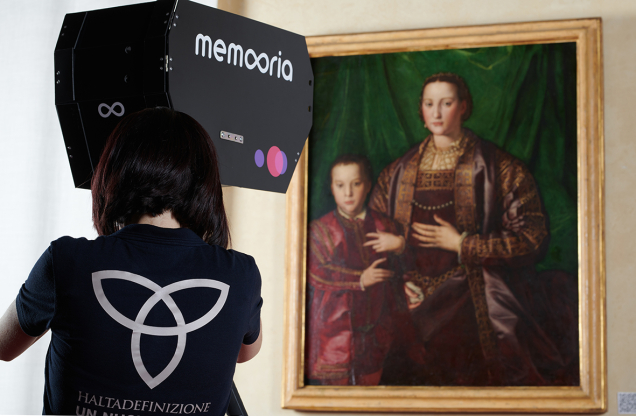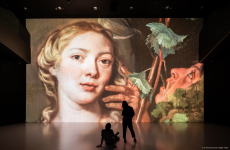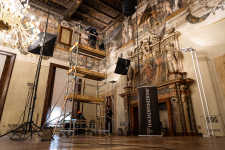After the digitalization of The Miracle of the Two Hanged Men by Raphael, the busy collaboration between Haltadefinizione and the regional museums of Tuscany continues with the ultra-high resolution digital acquisition of the portrait of Eleonora di Toledo with her son Francesco, painted in 1549. It is one of the most important works in the National Museum of the Palazzo Reale in Pisa, and is attributed to Bronzino.
The making of digital copies of fine art is a basic and complementary path toward the enhancement of the artistic heritage in museums. The ultra-high definition images of works of art become a kind of partner with the original, leading to a deeper understanding and a more carefull viewing of the original work. They offer new and valuable points of view to art lovers, students of art history, and to teachers and students in schools.
Bronzino’s portraits are typical of the official portrait style of the Medici court of Cosimo I, the first Grand Duke of Tuscany. They portray his wife Eleonora in an idealized and codified image of a proud woman, strong-willed and detached. In the portrait in the Palazzo Reale, she is depicted as a mother with her son, Francesco. Her dress is crimson, the preogative color of the grand ducal court. Spanish style and the appearance of an international style will give birth to new criteria of elegance and the flowering of a new fashion, influenced by the grand duchess. These excellent paintings provide direct visual access today to a rich time in the lives of the Medici dukes.
In fact, there are several versions of this portrait; the most famous one is in the Uffizi Gallery and it is also available in ultra-high definition Gigapixel format, in Haltadefinizione’s online archive. That painting is famous for its depiction of her sumptuous clothing. The version of the portrait in Pisa is equally rich in its details, the finely painted precious cloth, jewels and pearls that adorn the Grand Duchess. Now, with ultra-high definition Gigapixel imaging, the beauty in every little detail of this work can be observed and enlarged. You can zoom in on single brush strokes and observe its material compositon at close range.
Fabrizio Vallelonga, Director of the museum, explains: “In the Museum of the Palazzo Reale, the Bronzino portrait is displayed in a visual dialog with an actual courtly dress in crimson velvet which probably beloned to Eleonora herself and which bears a strong resemblance to the one in the painting. This is a unique comparison between a mid-sixteenth century dress and the painting, which today we can see online in all of its finest detail.
Stefano Casciu, regional Director of the museums of Tuscany, agrees: “This exhibltion with Bronzino’s portrait and the courtly dress that perhaps belonged to Eleonora is one of the most eloquent among the many threads that unite the museums of Pisa, the Palazzo Reale and San Matteo. The dress comes from the former monastery of San Matteo in Soarta, which was once connected to the Medici residence in that town. Once it was released by the household, it was donated to the nuns of San Matteo who for many years used it to dress a wooden statue of the Virgin Mary. The display of the dress and the portrait by Bronzino (which was itself recovered in a storage room at San Matteo) is the most complete expression of the power of the two museums together, while it also shows the deep connection between the dynasties of the Grand Duchy and Pisa’s own history.”
Says Luca Ponzio, founder of Haltadefinizione, “We are quite pleased to continue our collaboration with the office of the Director of Museums of the Region of Tuscany, because it has shown the value of digitalization and how it offers opportunities to spread knowledge about the arts while it also helps us to monitor the status of the works.”



